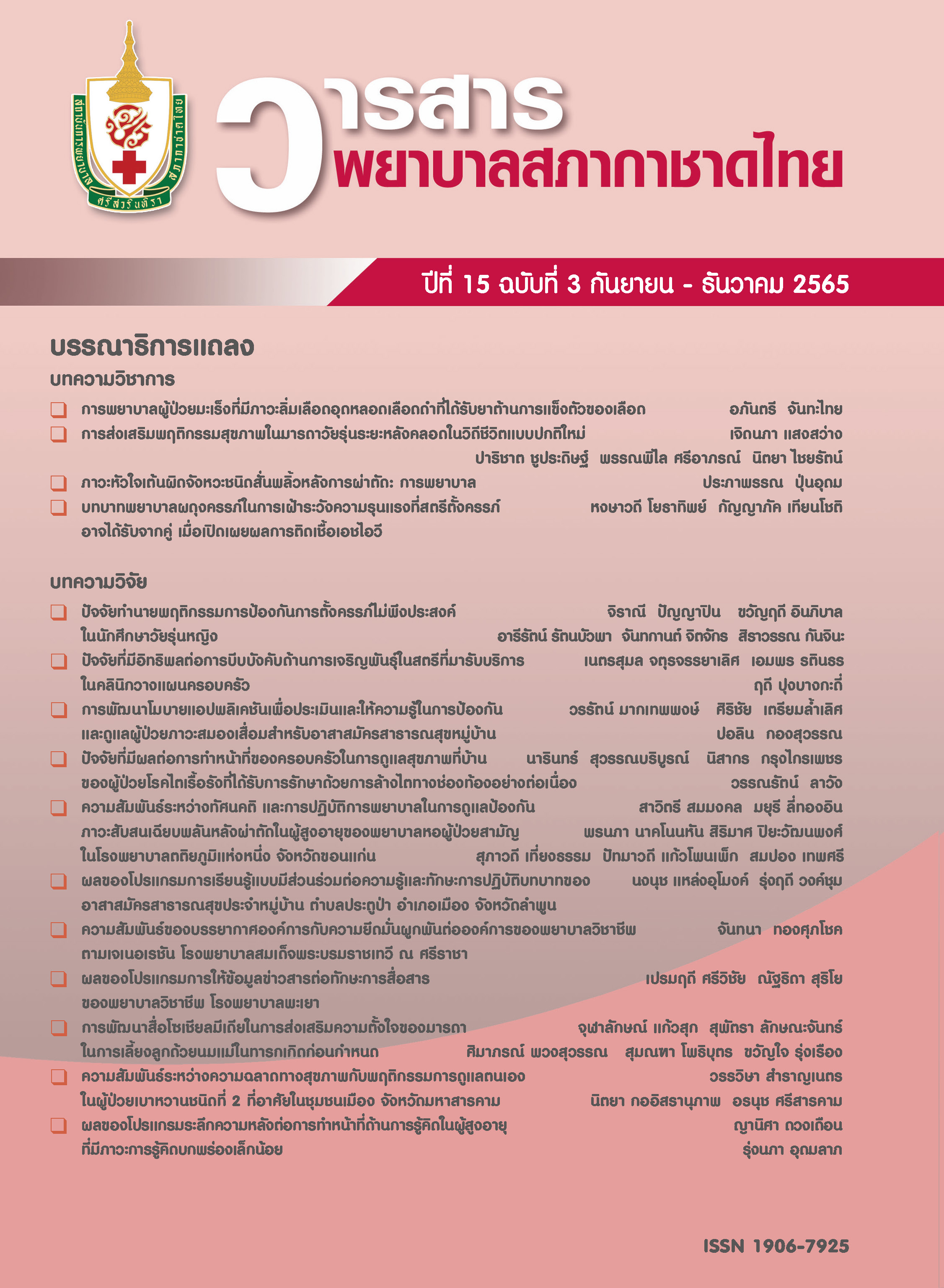The Role of Midwives in Surveilling Violence that Pregnant Women may Face from their Partner when Disclosing HIV-Infection
Keywords:
role of midwife, pregnant women, HIV infection, intimate partner violenceAbstract
Pregnant women with HIV are at risk of violence from their intimate partner. This is because disclosure of their HIV status may evoke controversial issues that can damage them both physically and mentally. These HIV-infected women hence feel apprehensive about informing their partners; thus, this hinders access to support them. Today, although there are guidelines for the care of pregnant women with HIV, few healthcare staff have actual experience or are aware of their entire nursing roles because patients in this group are both physically and mentally vulnerable. Also, these people are prone to stigmatization and discrimination from society. Therefore, midwives need to be conscious about the possibility of violence from their intimate partner vi ol ence when disclosing their HIV status. They need to consider their main responsibilities including direct care, education, counselling, empowerment, providing reasoning and ethical decision-making, and collaboration to support healthy pregnancies.
References
UNICEF. Reimagining a resilient HIV response for children, adolescents and pregnant women living with HIV [Internet]. 2020 [cited 2022 Mar 17]. Available from: https://www. childrenandaids.org/sites/default/files/2020-11/2020%20World%20AIDS%20Day%20 Report%20Final.pdf
Bureau of Epidemiology Department of Disease Control. HIV prevalence Thailand; 2018. Nonthaburi: AIDS, Tuberculosis and STDs Surveillance System Development Group; 2019. (in Thai)
National Statistical office of Thailand. Situation survey of children and women in Thailand project (2019). Bangkok: Forecast Statistics Division National Statistical Office; 2020. (in Thai)
Department of Disease Control. Thailand national guidelines on HIV/AIDS treatment and prevention 2021-2022. Nonthaburi: Division of AIDS and Sexually Transmitted Sexual Intercourse Department of Disease Control. The Ministry of Public Health; 2021. (in Thai)
Noorod C, Chaimay B, Woradet S. Pregnant women infected with HIV: a literature review on infant health outcomes. The Southern College Network Journal of Nursing and Public Health 2018;5(1):297-314. (in Thai)
Yonga AM, Kiss L, Onarheim KH. A systematic review of the effects of intimate partner violence on HIV-positive pregnant women in sub-Saharan Africa. BMC Public Health 2022;22(1):220. doi: 10.1186/s12889-022-12619-w.
Wetzel EC, Tembo T, Abrams EJ, Mazenga A, Chitani MJ, Ahmed S, et al. The relationship between intimate partner violence and HIV outcomes among pregnant women living with HIV in Malawi. Malawi Med J 2021;33(4):242-252.
Yothathip H, Thananowan N, Yusamran C, Vongsirimas N. Factors predicting intimate partner violence among pregnant women with sexually transmitted infections. Princess of Naradhiwas University Journal 2019;11(2):35-48. (in Thai)
Ashaba S, Kaida A, Coleman JN, Burns BF, Dunkley E, O’Neil K, et al. Psychosocial challenges facing women living with HIV during the perinatal period in rural Uganda. PLoS One 2017;12(5):e0176256. doi: 10.1371/journal.pone.0176256.
Pookboonmee R. Success role of APN in using case management. Thai Journal of Nursing and Midwifery Practice 2014;1(1):83-91. (in Thai)
Boonyakiat S, Charoenphong C. Nursing role and screening about infection disease in pregnant women. Kuakarun Journal of Nursing 2016;23(1):163-79. (in Thai)
Shamu S, Zarowsky C, Shefer T, Temmerman M, Abrahams N. Intimate partner violence after disclosure of HIV test results among pregnant women in Harare, Zimbabwe. PLoS One 2014;9(10):e109447. doi: 10.1371/journal.pone.0109447.
Katushabe E, Asiimwe JB, Batwala V. Intimate partner violence disclosure and associated factors among pregnant women attending a city hospital in South-Western Uganda: a cross-sectional study. BMC Pregnancy and Childbirth 2022;22(1):1-9. doi: 10.1186/s12884-022-04812-x.
Agenagnew L, Tebeje B, Tilahun R. Disclosure of intimate partner violence and associated factors among Victimized women, Ethiopia, 2018: a community-based study. Int J Reprod Med 2020;2020:6513246. doi: 10.1155/2020/6513246.
Thananowan N. Violence against women: analysis and conclusions of the research evidence. Bangkok: V. print (1991); 2014. (in Thai)
FHI 360. The HIV counselling handbook for the Asia-Pacific [Internet]. 2022 [cited 2022 Mar 18]. Available from: https://www.fhi360.org/resource/hiv-counseling-resource-package-pdf-thai
Child and Adolescent Mental Health Rajanagarindra Institute. Online mental health assessment [Internet]. 2019 [cited 2022 Mar 18]. Available from: https://new.camri.go.th (in Thai)
McFarlane J, Parker B, Soeken K, Bullock L. Assessing for abuse during pregnancy: severity and frequency of injuries and associated entry into prenatal care. JAMA 1992;267(23):3176-8.
Government Gazette. Act promote the development and protection of family institutions [Internet]. 2019 [cited 2022 Mar 18]. Available from: http://www.ratchakitcha. soc.go.th/DATA/PDF/ 2562/A/067/T_0171.PDF. (in Thai)
Puektes S, Poolperm K. Ethical dilemmas and ethical decision making for midwifery in the Thailand 4.0 Era. Journal of Nursing Science & Health 2020;43(3):1-11. (in Thai)
Boonnate N, Phaowiriya H. Screening for intimate partner violence in women: perspectives from health care providers. The Journal of Faculty of Nursing Burapha University 2018;26(4):80-9. (in Thai)
Stapleton S, Foley A, Barnason S, Proehl J. Clinical practice guideline: intimate partner violence. Journal of Emergency Nursing 2019;45(2):1-32.
ENA Clinical Practice Guideline Committee, Stapleton SJ, Bradford JY, Horigan A, Barnason S, Foley A, et al. Clinical practice guideline: intimate partner violence. J Emerg Nurs 2019;45(2):191.e1-191.e29. doi: 10.1016/j.jen.2019.01.016.
Soliman HF AE, Shokry WM, Abdullhameed SM. Pregnancy outcomes and empowerment-based nursing intervention against intimate partner violence for pregnant women. IOSR-JNHS 2017;6(6):78-89.
Downloads
Published
Issue
Section
License
Copyright (c) 2023 Srisavarindhira Thai Red Cross Institute of Nursing

This work is licensed under a Creative Commons Attribution-NonCommercial-NoDerivatives 4.0 International License.
เนื้อหาบทความหรือข้อคิดเห็นต่างๆ ในวารสารพยาบาลสภากาชาดไทยนี้ เป็นความคิดเห็นของผู้เขียนบทความ ไม่ใช่ความเห็นของกองบรรณาธิการ หรือสถาบันการพยาบาลศรีสวรินทิรา สภากาชาดไทย






